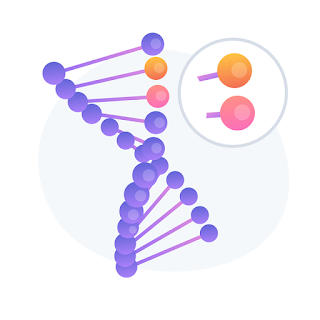DNA Changes and Your Health || BioAro
Almost all of the body's cells contain deoxyribonucleic acid (DNA). Each person's genetic makeup gives them their individuality. DNA contains the instructions necessary for all life to develop, grow, reproduce, and function.
The genetic code explains why some people have blue eyes instead of brown eyes, why some birds only have two wings, and why giraffes have lengthy necks. Being prone to particular diseases can also result from variations or mutations in the genetic code.
Not only does DNA exist in almost every cell in the body, but if unravelled and stretched end-to-end, a single cell's DNA would measure over 6.5 feet (ft) long.
What is DNA?
The genetic code for every individual is contained in a lengthy molecule called DNA. It contains the instructions required to assemble the proteins required for proper body operation.
About half of a child's DNA comes from the mother and half from the father as parents pass on DNA instructions to their offspring.
How is the DNA organized?
DNA is a two-stranded molecule that has the appearance of being twisted, giving it a distinctive structure known as the double helix.
The two strands are each made up of a substantial number of nucleotides. These are the DNA's basic building blocks, and they consist of a deoxyribose sugar molecule with five carbons and a nitrogen-containing region, along with a phosphate molecule.
There are four different categories of nitrogen-containing regions known as bases, including,
● adenine (A)
● cytosine (C)
● guanine (G)
● thymine (T)
The genetic code, which contains the instructions for life, is made up of the order of these four bases.
The bases of the two DNA strands are bonded together to form a ladder-like structure. The "rungs" of the ladder are made by A sticking to T and G sticking to C. The sugar and phosphate groups help the ladder's length to develop.
What is gene?
A gene is any segment of DNA that codes for a particular protein. For instance, one gene produces the insulin protein, which functions as a hormone to help regulate blood sugar levels. There are thought to be 30,000 genes in humans, although exact numbers are unknown.
It is estimated that only 1% of DNA is made up of genes that code for proteins. The remaining 99% of DNA, whose purpose is less well understood, is thought to have a role in controlling transcription and translation.
The largest chromosome, chromosome 1, has about 2,800 genes . With about 750 genes, chromosome 22 is the smallest.
How does DNA function?
The majority of DNA is found in cell nuclei, whereas a small amount is also found in mitochondria, the powerhouses of the cell.
Human DNA must be packaged extremely carefully since the nuclei are so little and there is so much of it.
DNA strands coil, loop, and wrap around histone proteins. DNA is referred to as chromatin when it is curled up like this.
Chromosomes are structures made of chromatin that have undergone further condensing through a supercoiling process. The well-known "X" shape of these chromosomes is formed.
One DNA molecule can be found on each chromosome. The total number of chromosomes in humans is 46, or 23 pairs. There are different numbers for other species. Fruit flies, for instance, have 8 chromosomes, but pigeons have 80.
Get more information
Please visit us :- https://bioaro.com/
follow on us
Facebook :- https://www.facebook.com/BioAroinc/
Twitter :- https://twitter.com/bioaroinc
LinkedIn :- https://www.linkedin.com/company/bioaroinc




Comments
Post a Comment